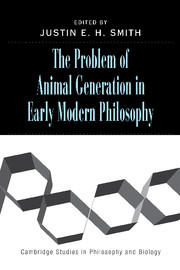Book contents
- Frontmatter
- Contents
- List of Contributors
- Introduction
- I THE DAWNING OF A NEW ERA
- II THE CARTESIAN PROGRAM
- III THE GASSENDIAN ALTERNATIVE
- IV SECOND-WAVE MECHANISM AND THE RETURN OF ANIMAL SOULS, 1650–1700
- V BETWEEN EPIGENESIS AND PREEXISTENCE: THE DEBATE INTENSIFIES, 1700–1770
- 11 Explanation and Demonstration in the Haller-Wolff Debate
- 12 Soul Power: Georg Ernst Stahl and the Debate on Generation
- 13 Charles Bonnet's Neo-Leibnizian Theory of Organic Bodies
- VI KANT AND HIS CONTEMPORARIES ON DEVELOPMENT AND THE PROBLEM OF ORGANIZED MATTER
- VII KANT AND THE BEGINNINGS OF EVOLUTION
- Bibliography
- Index
13 - Charles Bonnet's Neo-Leibnizian Theory of Organic Bodies
Published online by Cambridge University Press: 06 August 2009
- Frontmatter
- Contents
- List of Contributors
- Introduction
- I THE DAWNING OF A NEW ERA
- II THE CARTESIAN PROGRAM
- III THE GASSENDIAN ALTERNATIVE
- IV SECOND-WAVE MECHANISM AND THE RETURN OF ANIMAL SOULS, 1650–1700
- V BETWEEN EPIGENESIS AND PREEXISTENCE: THE DEBATE INTENSIFIES, 1700–1770
- 11 Explanation and Demonstration in the Haller-Wolff Debate
- 12 Soul Power: Georg Ernst Stahl and the Debate on Generation
- 13 Charles Bonnet's Neo-Leibnizian Theory of Organic Bodies
- VI KANT AND HIS CONTEMPORARIES ON DEVELOPMENT AND THE PROBLEM OF ORGANIZED MATTER
- VII KANT AND THE BEGINNINGS OF EVOLUTION
- Bibliography
- Index
Summary
The Genevan naturalist Charles Bonnet (1720–93) occupies a central place in the history of theories of generation. In his Considérations sur les corps organisés (1762), as in his later works, he strove to establish a coherent, empirically grounded theory of generation capable of overturning the epigenetic hypotheses stemming from the natural philosophies of Pierre-Louis Moreau de Maupertuis (1698–1759), Georges-Louis Leclerc de Buffon (1709–88), and John Turberville Needham (1713–81). In order to achieve this task, he benefited from the experimental discoveries and analyses of his friend, the illustrious Swiss physiologist Albrecht von Haller (1708–77). After long doubt as to what position to adopt, Haller firmly committed himself to the hypothesis of the preexistence of the preformed organism in the egg, which was to account for all the phenomena involved in the embryo's fertilization and development. He was particularly concerned with disproving epigenetic explanations that seemed to follow from empirical arguments, such as those set forth by Caspar Friedrich Wolff (1733–94) in his Theoria generationis (1759) and in his Theorie von der Generation (1764). Still, as a partisan of Newtonian methodology, Haller hesitated to use his research to create a theoretical system that could guide the interpretation of specific processes taking place beyond the field of visible appearances. This was precisely the task which Bonnet set himself in a “philosophical spirit, [consisting] principally in the analysis of facts, in the judgment of these facts, in their comparison, in the art of determining their consequences, of linking them together, and of revealing in this way the principles that naturally result from the best observed facts.
- Type
- Chapter
- Information
- The Problem of Animal Generation in Early Modern Philosophy , pp. 285 - 314Publisher: Cambridge University PressPrint publication year: 2006
- 2
- Cited by

